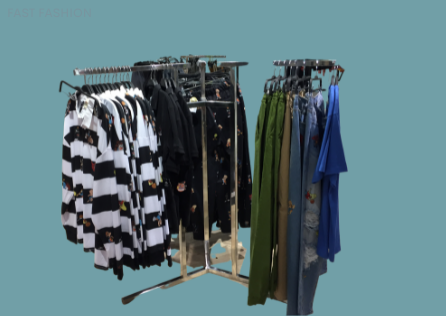Misconceptions of Thrifting and Fast Fashion

A clothing rack of clothes from Forever 21 in the Tysons Corner Mall. Fast fashion retailers such as Forever 21 produce inexpensive clothes rapidly in response to the latest trends.
From popular videos made by big creators such as Emma Chamberlain, “Thrift Hauls” and ““Thrift With Me” videos have arguably played a big part in the recent spike in “thrifting” sales.
The term “thrifting,” refers to shopping in used clothing stores such as Goodwill, The Salvation Army, and Plato’s Closet. Thrifting has grown in popularity over the past couple of decades and has become a trend amongst Generation Z. However, there are still a lot of misconceptions regarding thrifting and its impacts on the planet.
Thrifting
Over time, going thrifting has become a fun activity people can do with their friends, but many have forgotten what was meant to be the main purpose of thrifting: to better the environment and serve low-income families.
As consumers, we are easily attracted to lower-priced goods, but, admittedly, we can go overboard by buying in large quantities. These shoppers forget that thrift stores were originally built to benefit low-income buyers with their clothing needs. Those low-income buyers are getting the short end of the stick by potentially not having the time, like the more privileged buyers, to go to these thrift stores when they’re restocking and get the items they need the most.
Social media plays a huge role in the popularity of thrifting, positively and negatively. At times, influencers take advantage of their fame and try to convince their audience to go out and buy from online stores like Depop and Poshmark. These stores, however, often involve the sellers going out and thrifting just for the purpose to resell the items to gain more profit. This defeats the whole purpose of thrifting and just adds to more landfill.
Thrifting may be a great alternative to fast fashion, but as impatient teenagers, thrifting can be a hit or miss and the stores are very limited; thus attracting teenagers to their more accessible fashion counterparts: fast fashion stores.
Fast Fashion
Fast fashion, by definition, is inexpensive clothing produced rapidly by mass-market retailers in response to the latest trends. Teens’ favorite stores like H&M and Zara are considered fast fashion. Because of these cheap prices and trendy styles, buyers become more drawn to the clothing and tend to buy excessively. This then leads to the environmental problem of clothing waste due to overconsumption. On average, Americans throw away 10.5 million tons of clothing each year. This may be happening because of how trends go out of style quickly. Once the trend is over, they have the desire to throw it away. Then continues the cycle of buying and throwing away clothes.
According to an article by Race to a Cure, most fast fashion factories use non-biodegradable synthetic fibers, namely polyester and nylon, which are obtained from fossil fuels. When fossil fuels are burned they release carbon dioxide which traps heat in our atmosphere, making them a huge cause of global warming.
Ms. Ethridge, a fashion teacher at Patriot, offered her insight on how teenagers can limit the number of clothes being thrown away.
“The difficult problem is that fast fashion items are the things that most people are buying right now and they don’t biodegrade,” Ethridge said. “I think that we need to move back to using natural fabrics and things that can withstand washings, rather than wear and tears.”
Natural fabrics are cloth made out of fibers derived from plants or animals, like wool, cotton, and silk. The majority of these fabrics are biodegradable and more sustainable for the environment. Natural fabrics are often more expensive than the average synthetic fibers which are used more in clothes today. These natural fabrics are more costly due to the amount of time, effort, and money it takes to produce them. Synthetic fibers are materials like nylon, polyester, and spandex which are not biodegradable. These fibers shed microplastic fibers into the environment which have major effects on aquatic life and human health. Unfortunately, these synthetic fibers are running the fashion industry and have taken a toll on the planet.
Student Insight
Patriot High School has an ECO (Environmental Conservation Organization) Club which helps tackle the effects that the fashion industry has on the planet.
ECO Club officer Elizabeth Short (‘22) included her take on combating fast-fashion induced problems as high school students.
“I think urging our friends and family to stop consuming fast fashion is one of the biggest steps we can take as high schoolers,” Short said. “Also, not shopping at fast-fashion retailers helps. Some changes individuals can make are to thrift or use online thrift stores or to stop buying as many clothes as possible and rewearing what you already have helps a lot.”
Moreover, contributing to the problem is overconsumption as a result of this stigma of not repeating an outfit more than once. However, this can leave a toll on the planet. One in three women consider a garment old after one or two wears. Not repeating an outfit can cause more people to throw away their clothes, when later end up in landfills.
Even though there is more awareness surrounding fast fashion, and people continue to go thrifting, it still happens to be an on-going issue because of the expenses of the other alternatives. Thus, the costs of thrifting plus the benefits must be considered before contributing.
Your donation will support the student journalists of Patriot High School. Your contribution will allow us to purchase equipment and cover our annual website hosting costs.






